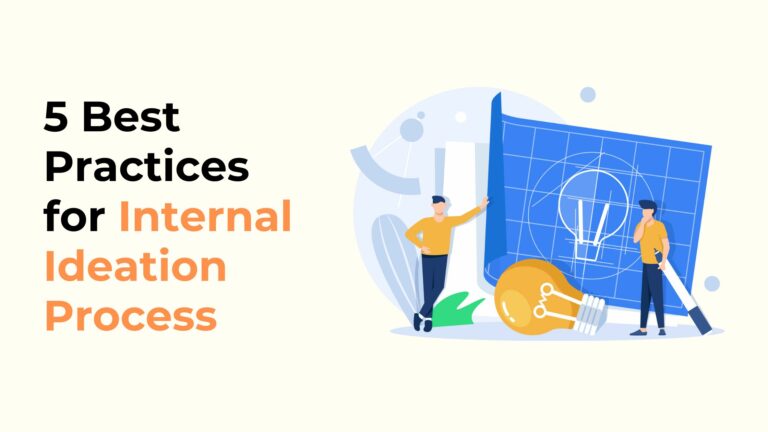Coming up with out-of-the-box ideas can be challenging when your team feels pressured. That’s when a well-structured internal ideation process becomes essential. Beause brainstorming sessions alone don’t cut it anymore.
You need a system that not only sparks creativity but also turns generated ideas into real innovations.
According to Forbes, spontaneity and a strong sense of community are key drivers of successful brainstorming sessions. But how do you turn that energy and consistently generate, manage, and implement valuable ideas?
That’s exactly what we’ll explore in this blog post: the five best practices to improve your internal ideation process.
The Importance of Planning Your Internal Ideation Process
When it comes to enterprise innovation, a Technology Trends Outlook 2024 report by McKinsey highlights the importance of systematic ideation. There can be advancements in generative AI only if we accelerate innovation across industries. Similarly, innovations must be properly planned if you want them to reach their full potential.
Planning can create a good balance between ideation and strategy. For instance, elaborate plans help:
- Ensure a systematic internal ideation process to deal with business challenges.
- Give purpose to the brainstorming session for generating new opportunities.
- Turn careful planning into a habit for the organization to redefine ideas.
- Increase the odds of a successful execution to create a structured framework.
The top leaders at GreyB, a business innovation consulting company, used InspireIP, an idea management software, to create a successful innovation program.
They implemented the Idea Assist model to improve planning and capture ideas. It also helped them generate and implement the process to upskill programs, bringing a repository of ideas to reality.
5 Best Practices for Planning Internal Ideation Process
Planning an internal ideation process for innovation is never smooth. Some companies face challenges with age-old techniques, finding the right tool, and integrating existing processes.
What if there’s a way to transcend these challenges? Take a look at the five best practices:
1. The Right Idea Management Process
A successful idea management in any internal ideation process should contain the following steps:
- Gather diverse ideas from customers and employees through brainstorming and idea-generation sessions.
- Evaluate the feasibility by analyzing the ideas against your company’s goals through a transparent assessment process.
- Prioritize the selected ideas with the most promising development based on your business goals and criteria.
- Refine the selected ideas, turning them into action plans for execution and implementation as future strategies.
- Implement valuable ideas quickly without compromising the evaluation and validation process.
Doesn’t it seem too much to do manually?
You’ll need an idea management tool like Idea Assist by InspireIP for effective management and idea prioritization. With built-in AI-powered features, you can streamline the entire ideation workflow. It benefits businesses with idea organization and generation, helping users tap into new opportunities through cross-functional collaboration.
For instance, Idea Assist offers straightforward three-to-four step customizable workflows to guide ideation from conception to implementation backed by Responsible AI at every stage.
2. Creation of Collaborative Ideation Processes
USTER, a leader in textile machinery, managed to motivate 70% of employees to join their company-wide ideation sessions. They turned ‘innovation’ into an embedded habit for their workforce.
This proves that an innovation strategy stems from effective collaboration, where people connect on similar knowledge and add more layers to an original idea.
But how will you tie together idea management with the internal ideation process and collaboration? Here are a few tips to get your workforce into the collaborative spirit:
- Communicate the ‘why’ and the intrinsic motivations behind your ideation plan and process.
- Use the challenges method to find new solutions to problems by engaging employees in business operations.
- Go for different ideation methods like visual aids, writing, and brainstorming formats to meet various communication styles.
- Build a community spirit, inspiring employees to contribute to the ideation process through transparency and inclusivity.
- Establish clear objectives for the ideation sessions and assemble teams from various departments to encourage a broader perspective.
For some, idea-sharing can seem like a chore. Hence it is vital to make collaboration easy for everyone. This is where Idea Assist’s real-time collaboration features and automated notifications come in handy, by ensuring no valuable idea gets lost in email threads or disconnected systems.
For instance, say you’re using Microsoft Teams as your primary communication platform. By using InspireIP’s plug-in, you can brainstorm and capture productive ideas within Microsoft Teams in just a click. That way, no valuable idea will get lost in long email threads or disconnected systems.
3. Plan for Transparency and Clarity
Some employees won’t feel confident enough to share their ideas in the first session. That’s why organizations must stop one-time ideation and brainstorming workshops.

A report by Deloitte suggests that 88% of workers recognize the importance of trust and transparency between them and their employers. You must create an open environment where everyone feels safe to share their ideas.
The internal ideation process should consist of the following:
- Colleagues working together to portray innovation, avoiding debate or negative discourse.
- Using a creative abrasion process where ideas get challenged constructively to modify, explore, and create potential solutions.
- Encouraging different viewpoints to amplify transparency, leveraging organizational diversity.
InspireIP’s Idea Assist can help companies create a plan for clarity and transparency in their internal ideation process. The customizable evaluation criteria and timeline tracking features help create complete transparency and visibility in the ideation process.
Moreover, it facilitates open communication to increase engagement and rapid execution. Users can access document processes through real-time analysis. As a result, leaders can easily monitor progress, make data-driven decisions, and more.
4. Ensure Leadership Roles are Strongly Defined
According to a Harvard Business Publishing study, 70% of respondents say leaders must master effective behaviors to meet future business needs. This means, a company’s leadership should take the lead when it comes to the internal ideation process.
Thus, clarifying their responsibilities and communicating expectations to them is critical. This will help you define evaluators, project champions, facilitators, team supporters, and more.
Encourage accountability and foster a collaborative culture through proper training to manage conflicts and foster an inclusive environment. They should also have the following capabilities:
- Trust everyone’s ability to innovate and create.
- Nurture creative abrasion to leverage opinion disparities.
- Establish metrics for idea evaluation based on effectiveness in achieving outcomes.
- Manage tensions during brainstorming and ideation without confrontations.
- Facilitate communication and decision-making, allowing ideas to flourish.
- Maintain the community spirit when collaboration leads to tensions.
Here’s an example of how the leaders at GreyB, a leading business innovation consulting firm, managed to become more efficient using InspireIP’s automated workflows.
They achieved 70% faster research time, secured more patents, and grew their business.
Leaders could help teams improve due to the advanced reporting features, ensuring better collaboration.
This demonstrates how the right idea management tools can amplify leadership effectiveness.
5. Better Decisions With Idea Evaluation
At the end of any internal ideation process, choose the right ideas to pursue and the ones to discard. This step can make or break your entire innovation management efforts if not done correctly.
It’s important to understand that different types of improvement ideas will have different outcomes. Small, incremental changes will lead to different results than big, radical changes.
To measure success, make sure you set clear goals and track specific metrics that are relevant to your business needs.
Idea evaluation in the internal ideation process is important because it acts as a bridge between real-life testing and alteration. Qualitative and quantitative information during this step should involve:
- Idea filtration
- Collection
- Detailed evaluation
- Prioritization
- Implementation
- Feedback
For many businesses, leaders, and managers, idea evaluation can be daunting. Sometimes, this can even lead to bottlenecks. Thankfully, idea management solutions can help automate manual tasks, visualize communication, and more.
For instance, you can use InspireIP’s Idea Assist to assess ideas, using its AI-powered evaluation feature based on customizable criteria. It’s a great way to enhance ideas without AI taking over the entire process. Your team can also leverage this feature to brainstorm new services and products.
With Idea Assist, manage ideation and innovation from concept to implementation. Some of the features for proper idea evaluation include:
- Built-in AI brainstorming
- Real-time collaboration
- Automated email notifications
- Customizable workflows and timeline tracking
- Custom evaluation criteria
Parting notes
Planning the internal ideation process means considering many things and paying attention to detail. Businesses can succeed if they follow a strategic and goal-oriented ideation process and a tool like Idea Assist can go a long way in helping with that.
With Idea Assist, enterprises have accelerated their innovation cycle by 50 to 70%, while maintaining complete visibility and control over their ideation process.
Over 960 happy users and numerous success stories are a testimony to that. Here’s why our platform stands out:
- Complete lifecycle coverage for innovation and idea management.
- Customizable workflows, scalability for growing businesses, and integration capabilities.
- Easy-to-use and intuitive interface with automated notifications and clear process visibility.
Are you ready to foster an innovative culture with your internal ideation process? Do you want to emphasize employee engagement and highlight the alignment of strategic ideas?
Contact InspireIP today!



